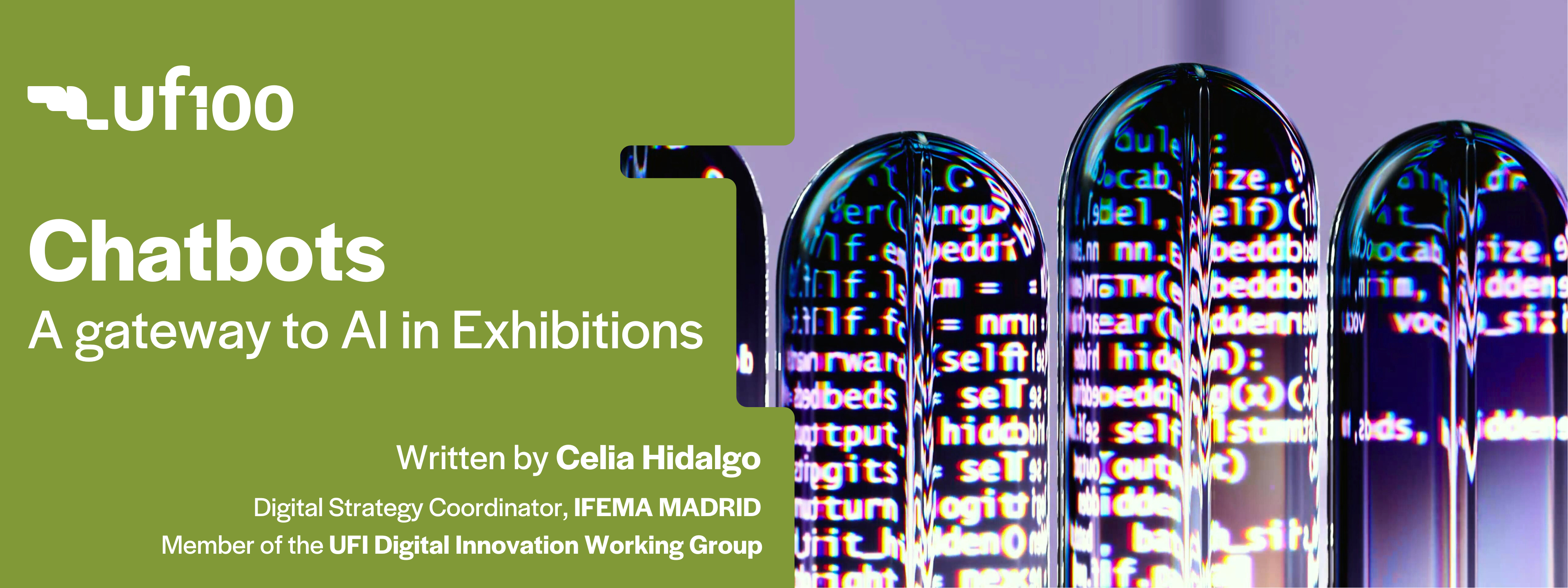Written by Celia Hidalgo, Digital Strategy Coordinator at IFEMA MADRID, Member of the UFI Digital Innovation Working Group and 2024 UFI Next Generation Leader.

If you resonate with the phrase “I just want to talk to a human,” then you’re familiar with early chatbots. However, modern chatbots are no longer just keyword-driven scripts. They can hold dynamic, context-aware conversations that feel increasingly natural, thanks to the integration of AI language models.
Chatbots’ value has always rested on their ability to answer user queries instantly. Even in their most rudimentary form—relying on pre-populated FAQs—they help customers resolve doubts without having to queue or wait for email replies. But AI-powered chatbots take this to the next level. Using Natural Language Understanding (NLU), they process complex, open-ended questions and deliver more relevant, tailored responses.
Moreover, AI integration has made chatbots indispensable in fast-paced industries like exhibitions and trade shows. Real-time information is critical not only during an event—think of attendees searching for directions or last-minute schedule updates—but also in the planning stages when exhibitors most likely require assistance for setting up their exhibition space. After all, navigating the complexities of event participation is rarely a straightforward process.
Beyond cost savings
One of the most compelling benefits of chatbots is their ability to handle standardized inquiries, which alleviates the workload on customer support teams and enhances operational efficiency. By automating routine tasks, chatbots reduce response times and cut costs significantly. According to a 2023 report by IBM, businesses can save up to 30% on customer support costs by implementing AI-powered virtual agents.
For example, many questions asked by attendees are repetitive, such as, “Can I attend the show with my [kid, friend, pet]?” A chatbot equipped with NLU can interpret these queries effortlessly, without being specifically trained on every possible type of companion a visitor might want to bring. This degree of automation not only improves efficiency but also reduces operational costs while maintaining customer satisfaction.
Knowledge is power
On top of that, chatbots serve as powerful tools for social listening and data collection: every interaction with a chatbot is an opportunity to gather actionable insights. According to Oracle, 85% of business leaders have experienced the challenges of decision fatigue and would rely on data for faster decision-making and risk management.
By leveraging chatbot-generated data, event managers can track trends, anticipate attendee needs, and refine their offering to ensure greater satisfaction and engagement. This data-driven approach also facilitates a more personalized experience, which helps increase conversion rates and even allows for up-selling opportunities.
Bridging the generational gap
Finally, chatbots are essential for catering to the preferences of younger generations, who value immediacy and self-service. A 2022 survey by Gartner found that almost 40% of Millennials and Gen Zers would rather not resolve their customer support issues if they can’t do it through self-service. This preference for self-service isn’t just a trend—it’s a reflection of how younger generations interact with technology. They expect seamless, on-demand solutions, and chatbots deliver exactly that by providing instant, 24/7 assistance.
By integrating chatbots into their communication strategies, exhibition organizers can bridge the generational gap, ensuring that all attendees—regardless of age—have a positive and engaging experience. While younger attendees may gravitate toward self-service options, older generations may still prefer human assistance, even when delayed. This allows customer support teams to focus their efforts on providing personalized help to those who need it most, creating a balanced and inclusive experience for everyone.
Overcoming chatbot risks for success
While this technology offers immense potential to bring companies closer to their customers, they are not without risks. One key challenge is the phenomenon of “hallucinations,” where AI-powered chatbots generate incorrect or nonsensical responses. This happens because chatbots, especially those based on large language models (LLMs), rely on data patterns rather than factual accuracy. To overcome this, it’s essential to define a structured framework of rules and parameters, and to regularly monitor and fine-tune prompts based on the answers provided.
In this sense, chatbots are not a “plug-and-play” solution. They require ongoing improvement and iteration, demanding both time and investment. Teams must analyze chatbot interactions, identify areas for enhancement, and update the system to reflect evolving customer needs and event requirements. This calls for alignment between product owners and customer support teams to cross-check data periodically, and management’s involvement to turn insights into strategic decisions.
Lastly, the success of a chatbot relies heavily on its integration with other systems and data sources, such as CRMs, customer support platforms, knowledge bases, and even floor planning tools. Also, given that our business is rooted in face-to-face interactions, every digital communication must complement and enhance that value by providing a comprehensive, omnichannel experience across all touchpoints.
Bringing us closer to clients
As the exhibition industry continues to evolve, tools like chatbots are set to play an even greater role in shaping the future of events. Their integration with broader AI capabilities sets the stage for advanced applications like predictive analytics, personalized marketing, and automated content curation. The ongoing evolution of chatbot technology, combined with data-driven insights, positions them as critical tools for enhancing both the attendee experience and operational efficiency, making them a realistic next step in the digital transformation of our industry.
In sum, thanks to their ability to streamline communication, gather insights, and enhance the overall event experience, chatbots are here to bring us closer to our clients by ensuring that every voice is heard—whether they’re speaking to a human or not.
References:
IBM (2023):
IBM. (2023). Digital customer care in the age of AI Energy. Retrieved from https://www.ibm.com/downloads/documents/us-en/107a02e94d48f8d8
Oracle (2023):
Oracle. (Apr 19, 2023). Global study: 70% of business leaders would prefer a robot to make their decisions [Press release]. PR Newswire. Retrieved from https://www.prnewswire.com/news-releases/global-study-70-of-business-leaders-would-prefer-a-robot-to-make-their-decisions-301799591.html Gartner (2023):
Rendelman, M. (2023, October 30). Adapting to the customer service preferences of Gen Z and millennials [Q&A]. Gartner. Retrieved from https://www.gartner.com/en/newsroom/press-releases/2023-10-30-adapting-to-the-customer-service-preferences-of-gen-z-and-millennials







Leave A Comment